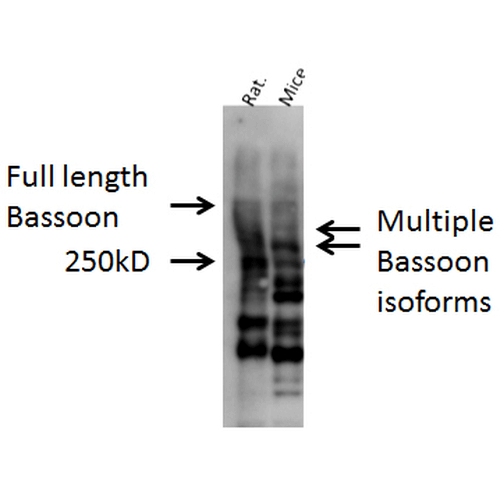SPC-198D-FITC
Scientist.com Supplier
Bassoon Antibody: FITC
Stressmarq Biosciences
Image

Image

DESCRIPTION
Rabbit Anti-Human Bassoon Polyclonal
DETAILS
- Target: Bassoon
- Gene Id: 8927
- Conjugate: FITC
- Immunogen: NM_003458.3 (AA 786-1041) N-terminal his-tagged fusion protein of human Bassoon
- References: 1. Anna Dondzillo et al., (2010) J. Comp Neur, 518(7): 1008–1029.
- Swiss-prot: Q9UPA5
- Specificity: Detects ~420kDa. Multiple isoforms can be detected.
- Applications: WB | IHC
- Field of Use: Not for use in humans. Not for use in diagnostics or therapeutics. For in vitro research use only.
- Host Species: Rabbit
- Product Type: Polyclonal
- Purification: Protein A Purified
- Concentration: 1 mg/ml
- Research Areas: Neuroscience | Cell Markers | Neuron Markers | Presynaptic Markers | Neuroscience | Neurodegeneration | Multiple System Atrophy
- Storage Buffer: PBS pH7.4, 50% glycerol, 0.09% sodium azide *Storage buffer may change when conjugated
- Accession Number: NP_003449.2
- Alternative Names: BSN Antibody, ZNF231 Antibody, Neuronal double zine finger protein Antibody
- Antibody Dilution: WB (1:1000), IHC (1:400); optimal dilutions for assays should be determined by the user.
- Cite This Product: StressMarq Biosciences Cat# SPC-198D-FITC, RRID: AB_2704140
- Immunogen Species: Human
- Storage Temperature: Conjugated antibodies should be stored according to the product label
- Shipping Temperature: Blue Ice or 4ºC
- Cellular Localization: Cytoplasm | Cell Junction | Synapse
- Scientific Background: Bassoon is a 420 kDa protein that is a localized at the presynaptic nerve terminals and is believed to play a role in the structural and functional organization of the synaptic vesicle cycle. Bassoon is predicted to contain two double-zinc fingers, three coiled-coil regions, and two polyglutamine domains. The polyglutamine domains in the C-terminus are of interest, since it is known that for some human proteins, such as Huntington, abnormal amplification of this region can cause late-onset neurodegeneration. Bassoon is concentrated at sites opposite to postsynaptic densities in synaptic terminals and in cultured neurons, it is found to co-localize with GABA (A) and glutamate (GluR1) receptors (1).
- Certificate of Analysis: 1 µg/ml of SPC-198 was sufficient for detection of Bassoon in 10 µg of rat brain tissue lysate by colorimetric immunoblot analysis using goat ant rabbit IgG:HRP as the secondary antibody.
- Species Reactivity Full Name: Human | Mouse | Rat
Equivalent Items
| ... Loading